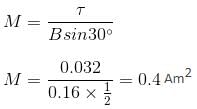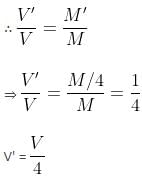Test: Magnetism and Matter - 1 - CUET Humanities MCQ
10 Questions MCQ Test Agriculture Practice Tests: CUET Preparation - Test: Magnetism and Matter - 1
A short bar magnet, placed with its axis at 30o with an external magnetic field of 0.16 T, experiences a torque of magnitude 0.032 J. The magnetic moment of the bar magnet ( in Am2) is
Which of the following substances shows permanent magnetism?
The effective length of a magnet is 31.4 cm and its pole strength is 0.5 A-m. What will be the magnetic moment if it is bent in the form of a semicircle?
At a point on the axial line of a bar magnet of dipole moment M, the magnetic potential is V. What is the magnetic potential due to a bar magnet of dipole moment M/4 at the same point?
Which of the following has the highest magnetic permeability?
The magnetism of a magnet is due to which of the following?
A magnetic needle is kept in a non-uniform magnetic field. It experiences
A bar magnet of magnetic moment 2.0 JT-1 lies aligned with the direction of a uniform magnetic field of 0.25 T. What is the work done to turn the magnet so as to align its magnetic moment opposite to the field direction?
A frog can be levitated in magnetic field produced by a current in a vertical solenoid placed below the frog. This is possible because the body of the frog behaves as a/an _______ substance.









 ).
). .
. = current × area of the loop.
= current × area of the loop. is also associated with electron. The vector sum of
is also associated with electron. The vector sum of  and
and  provides the net magnetic dipole moment
provides the net magnetic dipole moment  , to the atom.
, to the atom.  is much greater than
is much greater than  , hence magnetism of magnet is due to spin motion of electrons.
, hence magnetism of magnet is due to spin motion of electrons.













